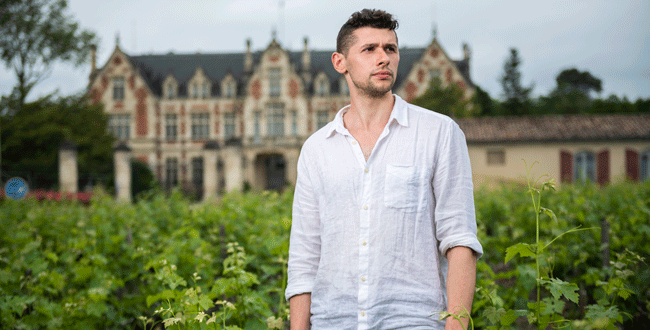The uninformed who meets the artist David Popa in the vineyards of Château Cantenac Brown is taken aback. Armed with two spray bottles, one in each hand, the boy twirls here and there in an improbable choreography, spraying multiple sprays of a violet-colored product on the gravel of the path, on the grass. He wears Neoprene diving shoes, is equipped with an audio helmet and a plastic breastplate which seems to support a whole sophisticated apparatus. From time to time, he lets out a powerful “Yes, David!”, like a battle cry. Then there he is on the ground, taking it into his head to empty a puddle of its contents, by hand. Near him, a whole mess of plastic buckets containing dark liquids. Witchcraft?
” READ ALSO: Margaux: why Brane-Cantenac is today a very good business
Decryption: New Yorker David Popa, 29, is creating what he calls “an earthly fresco”. The vaporizers are filled “natural paint, based on chalk, wine lees, green clay, black earth, the same materials used by the first artists of humanity to create cave paintings in their caves“, he explains. The sound escaping from his headphones is “a progressive 1990s trance that gives me maximum energy when working“. Plastic shoes? “They allow me to scratch the ground and correct the design or the colors“. Finally, let’s add to the list of equipment the monitor and the remote control of a drone which is hovering intermittently high above him because “the work is only visible from the sky”. A glance at the monitor allows you to view from the drone what Popa is doing: it is a painting of several tens of square meters which represents two open hands carrying a bunch of grapes. Superb and completely invisible from the ground floor. Even if the discovery of the fresco is done on screen, the emotion is real.
This is not Popa’s first attempt. It has been four years since he launched into terrestrial frescoes. In Finland, he made a portrait on the ice using the same technique.and the ice broke. It’s become completely different“. In one film, we see him jump from one sheet of ice to another to complete the XXL drawing. In the rocks of a Greek island, he paints the face of Prometheus “and some locals believed it had been there forever“. Each time, natureintervenes in the process», modifies the colors and the forms of the work, until time to erase it definitively. “This type of work is for me a mystical experience“. There are still videos, photographs, memories.
To create his fresco, David Popa spent a week in Cantenac Brown’s plot just opposite the castle gates. For the occasion, he was accompanied by his younger brother Nathan, director and film producer. The family is creative. Son of a graffiti artist of Romanian origin married to a Frenchwoman, grandson of ballet dancers, who attended a New York art school, David Popa combines in his work ancestral techniques, cutting-edge technologies and a deep desire of nature: “The set creates a nice balancehe says. His leitmotif:Rise Above!» («overcome !“).
A concern for the environment
This is his first collaboration with a company. “It is a real work in relation to the terroir. I like it“. One thinks of land art artists, of Christo in his early days, of course. But there is in Popa a concern for the environment, an attachment to the oldest tradition as well as to the new technologies which give his work all its contemporaneity.
Popa’s approach also echoes that of the property that invited him and whose watchword is “the power of the earth”. “We chose to work with David Popa because we knew he would be able to work exclusively with local and biodegradable materials that the rain will eventually return to nature, I really like this message, explains the owner, Tristan Le Lous. In addition, the graphic effect is very successful“. Bought at the end of 2019 by the Le Lous family, the estate is currently under construction. Both levels of the Tudor-style castle are renovated from top to bottom. Right next door, a building that housed around fifty rooms and a swimming pool will be transformed into a vat room. For the sake of eco-responsibility, the walls have not been knocked down but will integrate the next building. Everyone is surprised to discover these constructions from the 1990s supported by dozens of props, like the remains of Pompeii. Soon, these walls will become those of the vat room, after being lined with compressed earth or earth briquettes in order to naturally guarantee a constant temperature of 15°C all year round, without artificial air conditioning. The cooled air will come from Canadian wells dug into the ground. The work should be completed before the 2023 harvest.
Long before that, the video showing the work of David Popa will have been sold at auction, in the form of NFT, that is to say an inviolable digital file, for the benefit of the Conservatoire du littoral. The sale should occur in the fall.
The editor recommends:
The future of Margaux is also written in white in Brane-Cantenac
In Bordeaux, Cantenac Brown unveils its astonishing cob cellar project
» Margaux: Château Cantenac Brown 2015, the red heart of the editorial staff
We want to give thanks to the author of this write-up for this outstanding material
In Bordeaux, Château Cantenac Brown is repainting its land
Discover our social media accounts as well as other pages related to it.https://nimblespirit.com/related-pages/

